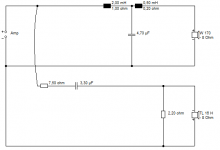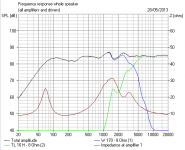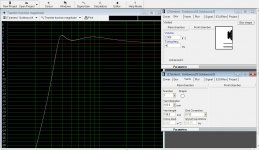Hello All,
I'm in the process of building my first speaker / amp project - a boombox based around a HelderHIFI T2024 MKV.
I used these woofers and these tweeters, with 2khz prebuilt crossovers. Using parts-express "optimum cabinet size" (sealed) I built enclosures at 0.79 feet cubed. The sound quality is quite good, although the bass is far less than I had hoped for, and drops off considerably outside of 1 foot away from the box. I should add that I'm using zobel networks on the woofers with a 10uf cap and a 10 Ohm resistor, plus an L-pad for the tweeters. I added some poly fill to each enclosure last night and didn't notice a huge difference.
Using the this speaker box enclosure designer I get a sealed box size of about 0.25 feet cubed - far less than what I've constructed. This discrepancy seems rather large...have I done some thing horribly wrong with my design? Am I expecting too much out of these cheapo woofers?
Any help would be greatly appreciated. Thanks in advance.
I'm in the process of building my first speaker / amp project - a boombox based around a HelderHIFI T2024 MKV.
I used these woofers and these tweeters, with 2khz prebuilt crossovers. Using parts-express "optimum cabinet size" (sealed) I built enclosures at 0.79 feet cubed. The sound quality is quite good, although the bass is far less than I had hoped for, and drops off considerably outside of 1 foot away from the box. I should add that I'm using zobel networks on the woofers with a 10uf cap and a 10 Ohm resistor, plus an L-pad for the tweeters. I added some poly fill to each enclosure last night and didn't notice a huge difference.
Using the this speaker box enclosure designer I get a sealed box size of about 0.25 feet cubed - far less than what I've constructed. This discrepancy seems rather large...have I done some thing horribly wrong with my design? Am I expecting too much out of these cheapo woofers?
Any help would be greatly appreciated. Thanks in advance.
Last edited:
2. Your choice of tweeter is suspect.
It's 100 dB/W/m
against a 88 dB/W/m woofer
You've got to loose 12 dB ( theory ) if not more ( electrical losses such as the coil before the woofer )
And in the end it's not even Hi-fi !
It's 100 dB/W/m
against a 88 dB/W/m woofer
You've got to loose 12 dB ( theory ) if not more ( electrical losses such as the coil before the woofer )
And in the end it's not even Hi-fi !
Perhaps I posted this in the wrong forum - Is there a "new to dyaudio" section where one may ask (arguably stupid) questions, and perhaps receive suggestions?
Thanks in advance.
Would this tweeter be a better fit?
Pioneer FBDD69-51F
3/4" horn loaded dome tweeter.
Ferrofluid cooled
SPECIFICATIONS
Nominal Diameter: 4.0", 102mm
Nominal Impedance: 8 ohms
Power: 45 W rms
Freq. Response: 2 kHz-20 kHz
Sensitivity: 90 db 1w/1m
Magnet Weight: 2.4 oz, 68 grams
Voice Coil Diameter: 0.74", 19mm
Min. X-over: 2 kHz/12dB
Pioneer FBDD69-51F
3/4" horn loaded dome tweeter.
Ferrofluid cooled
SPECIFICATIONS
Nominal Diameter: 4.0", 102mm
Nominal Impedance: 8 ohms
Power: 45 W rms
Freq. Response: 2 kHz-20 kHz
Sensitivity: 90 db 1w/1m
Magnet Weight: 2.4 oz, 68 grams
Voice Coil Diameter: 0.74", 19mm
Min. X-over: 2 kHz/12dB
Member
Joined 2009
There are many aspects to address in a successful speaker design, it's not as simple as connecting components together.
The first thing to match is the speaker sensitivity. However, woofers can lose up to 6dB depending on the box geometry and that needs to be addressed in the crossover as well as by selecting a less sensitive tweeter.
Crossovers a defined by slopes. A 4th order crossover means that your drivers must work for an octave beyond the crossover point. So for example a 4th order XO at 2kHz means that your woofer has to work till 4kHz and your tweeter to 1kHz.
Sadly, I don't think you can do much with what you have already. It's probably best to look at kits with pre-built crossovers and try to emulate the suggested boxes.
Speaker Kits in the Speaker Components Department at Parts Express | 286
The first thing to match is the speaker sensitivity. However, woofers can lose up to 6dB depending on the box geometry and that needs to be addressed in the crossover as well as by selecting a less sensitive tweeter.
Crossovers a defined by slopes. A 4th order crossover means that your drivers must work for an octave beyond the crossover point. So for example a 4th order XO at 2kHz means that your woofer has to work till 4kHz and your tweeter to 1kHz.
Sadly, I don't think you can do much with what you have already. It's probably best to look at kits with pre-built crossovers and try to emulate the suggested boxes.
Speaker Kits in the Speaker Components Department at Parts Express | 286
Would this tweeter be a better fit?
Pioneer FBDD69-51F
3/4" horn loaded dome tweeter.
Ferrofluid cooled
SPECIFICATIONS
Nominal Diameter: 4.0", 102mm
Nominal Impedance: 8 ohms
Power: 45 W rms
Freq. Response: 2 kHz-20 kHz
Sensitivity: 90 db 1w/1m
Magnet Weight: 2.4 oz, 68 grams
Voice Coil Diameter: 0.74", 19mm
Min. X-over: 2 kHz/12dB
The 90 dB sensitivity is a better match with the woofer.
The horn loading adds gain at the low end of the tweeter working band ( depending on mouth aperture and geometry of the horn) and as a plus it widens dispersion, which is important at croosver frequency, which dispersion (opposed to directivity, which is an 'issue' for high frequency ) has to meet woofer's own. Indeed, the most important thing is that at crossover frequency there are not abrupt changes with (from) the two different emissions of the two drivers. Me almost newbie

I have rarely encountered such a horrible combination, but have given it my best shot with similar Visaton W170 Bass and Visaton TL16H Horn.
This sort of circuit seems to be indicated for a 30L standmounter. How that relates to your situation is for you to decide...
Phase is actually quite good here.
This sort of circuit seems to be indicated for a 30L standmounter. How that relates to your situation is for you to decide...
Phase is actually quite good here.
Attachments
I have rarely encountered such a horrible combination
I'm honoured that my decisions have put me in such an exclusive group
In your schematic, I don't quite understand the resistor values under the inductor values (described by black rectangles). How are these wired?
Also, if one was to swap in these tweeters, would my situation be improved slightly?
Thanks for taking the time.
Can you expect hi-fi from $18 speakers?
It's 100 dB/W/m
against a 88 dB/W/m woofer
You've got to loose 12 dB ( theory ) if not more ( electrical losses such as the coil before the woofer )
And in the end it's not even Hi-fi !
The reason your not getting any useful bass output is that this woofer you now have is not suited to a sealed enclosure....it works far far better in a Ported enclosure. The simulation you used is crude to say the least. There are more complex simulations that consider far more variables & are therefore more accurate.
I ran your driver thru my simulator WinISD beta.....a common FREE simulation & found your bass driver will work just fine in a 3.018 cubic foot enclosure. With a common dimension ratio this works out to 13.763" by 17.341" by 21.848".
With a port size of 102mm diameter by 165mm long you can expect the bass to fade off at 30 Hz, or -3Db@30Hz as it is commonly written. A much smaller port should be used, perhaps half that diameter. Note that these are INSIDE dimensions. Changing the port size is easily plugged into this simulation.
Do yourself a big favor & build your box out of at least 3/4" material......I like to build with 1" material......I am assuming you used MDF or what's called Medium Density Fiberboard...you can reuse your stuffing in the other box, lining the insides.
_____________________________________________________Rick........
I ran your driver thru my simulator WinISD beta.....a common FREE simulation & found your bass driver will work just fine in a 3.018 cubic foot enclosure. With a common dimension ratio this works out to 13.763" by 17.341" by 21.848".
With a port size of 102mm diameter by 165mm long you can expect the bass to fade off at 30 Hz, or -3Db@30Hz as it is commonly written. A much smaller port should be used, perhaps half that diameter. Note that these are INSIDE dimensions. Changing the port size is easily plugged into this simulation.
Do yourself a big favor & build your box out of at least 3/4" material......I like to build with 1" material......I am assuming you used MDF or what's called Medium Density Fiberboard...you can reuse your stuffing in the other box, lining the insides.
_____________________________________________________Rick........
Last edited:
Now your getting it.....my version merely splits the "erratic response" right down the middle...up one Db for the first 'hill', down one Db for the valley.
Have fun with it & experiment. I've found some drivers simply cannot perform well down low no matter how you change things....they just don't want to work.
Try altering volume & tuning frequency...separately, & slowly....note how the waveform changes....try drivers with the EBP for vented as sealed & vice versa. Try to keep the vent pipe as short as possible because it takes up a small portion of internal volume, somewhat throwing off your tuning.
_________________________________________________Rick.........
Have fun with it & experiment. I've found some drivers simply cannot perform well down low no matter how you change things....they just don't want to work.
Try altering volume & tuning frequency...separately, & slowly....note how the waveform changes....try drivers with the EBP for vented as sealed & vice versa. Try to keep the vent pipe as short as possible because it takes up a small portion of internal volume, somewhat throwing off your tuning.
_________________________________________________Rick.........
Last edited:
I suggest that you go to the Parts Express "Tech Talk" forum and ask if anyone has measured that woofer - point us to the measurements if you find them.
Most would use it with a dome tweeter, the HiVi K1 is a decent low cost tweeter:
The Madisound Speaker Store
But there is no reason why you can't get decent sound with a horn, if it is a good one. I've never seen measurements of that one and it looks like a very old design rather than a modern waveguide. This is a good, modern inexpensive horn tweeter also note that there is a DIY kit referenced there but the crossover is rather complex:
Denovo Mini Elliptical - Compression Drivers DIY Sound Group
However, it is difficult to get good sound just by combining parts you need to follow a logical design process. I believe that there might be some worked out designs using that woofer on the PE forum. Point us to it if you find one and I'll comment on it.
Prebuilt crossovers usually do not employ baffle step compensation and this would explain your weak bass issue.
It is actually good that the box is large, vent tune it to 42 Hz and you might see a significant improvement. Just line the walls with damping if you vent it.
Most would use it with a dome tweeter, the HiVi K1 is a decent low cost tweeter:
The Madisound Speaker Store
But there is no reason why you can't get decent sound with a horn, if it is a good one. I've never seen measurements of that one and it looks like a very old design rather than a modern waveguide. This is a good, modern inexpensive horn tweeter also note that there is a DIY kit referenced there but the crossover is rather complex:
Denovo Mini Elliptical - Compression Drivers DIY Sound Group
However, it is difficult to get good sound just by combining parts you need to follow a logical design process. I believe that there might be some worked out designs using that woofer on the PE forum. Point us to it if you find one and I'll comment on it.
Prebuilt crossovers usually do not employ baffle step compensation and this would explain your weak bass issue.
It is actually good that the box is large, vent tune it to 42 Hz and you might see a significant improvement. Just line the walls with damping if you vent it.
Last edited:
..together with the high sensitivity tweeter, I can imaginePrebuilt crossovers usually do not employ baffle step compensation and this would explain your weak bass issue.

Also the Fs ( resonance frequency) of the woofer is a little bit high for a woofer
of that diameter. I mean, is not that important but it implies that the engineering of that driver has brought to that parameter. Suspensions, motor, cone weight ...
There's an easy fix to get you going. 
Get yourself a miniDSP and a couple of cheap amps. This will allow you to experiment with crossovers and filter in an easy manner.
It might not always be the best final solution but you can't beat it for experimentation purposes.
Best of luck.
Get yourself a miniDSP and a couple of cheap amps. This will allow you to experiment with crossovers and filter in an easy manner.
It might not always be the best final solution but you can't beat it for experimentation purposes.
Best of luck.
- Status
- This old topic is closed. If you want to reopen this topic, contact a moderator using the "Report Post" button.
- Home
- Loudspeakers
- Multi-Way
- Help with bass response on my first build...


